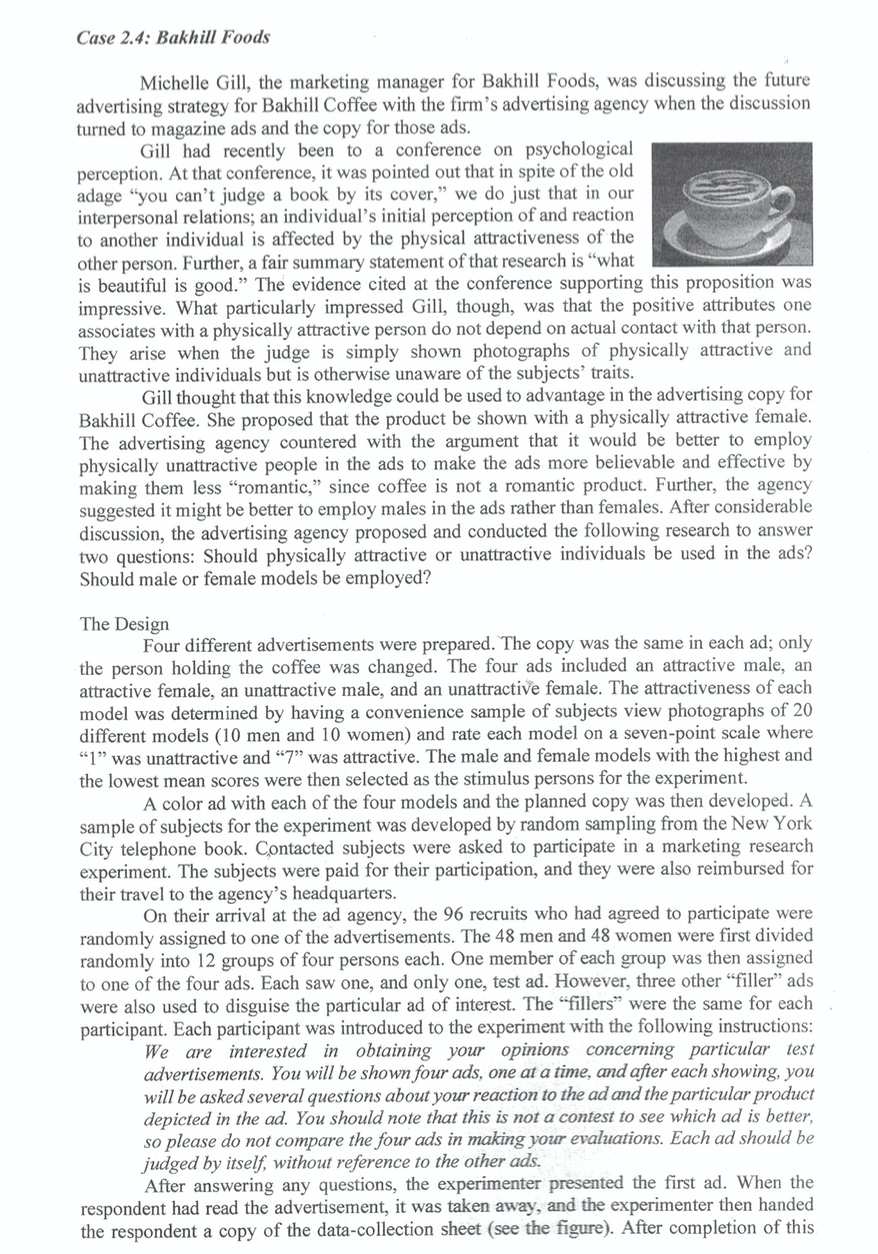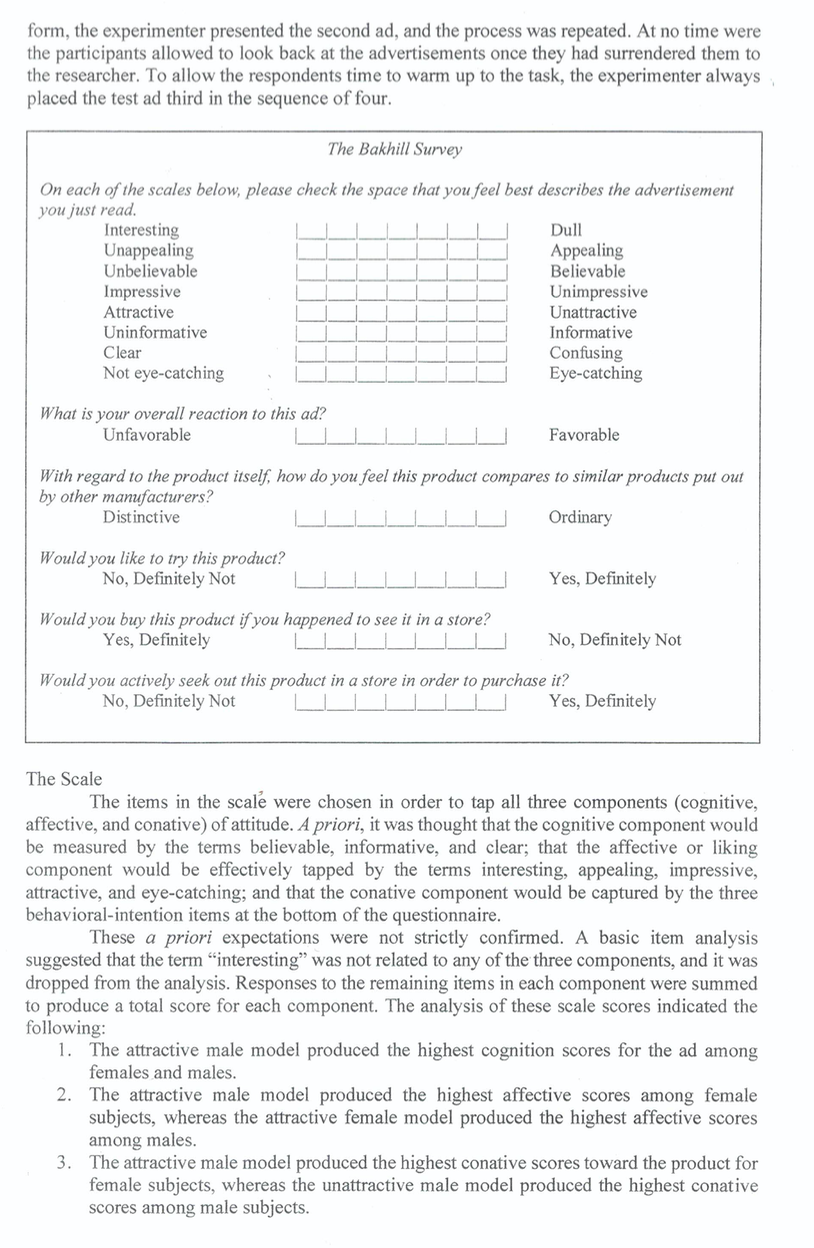Case 2.4: Bartlet?! Foods Michelle Gill, the marketing manager for Bakhill Foods, was discussing the future advertising strategy for Bakhill Coffee with the firm's advertising agency when the discussion turned to magazine ads and the copy for those ads. Gill had recently been to a conference on psychological perception. At that conference, it was pointed out that in spite of the old adage \"you can't judge a book by its cover,\" we do just that in our interpersonal relations; an individual's initial perception of and reaction to another individual is affected by the physical attractiveness of the other person. Further, a fair summary statement of that research is \"what is beautiful is good.\" The evidence cited at the conference supporting this proposition was impressive. What particularly impressed Gill, though, was that the positive attributes one associates with a physically attractive person do not depend on actual contact with that person. They arise when the judge is simply shown photographs of physically attractive and unattractive individuals but is otherwise unaware of the subjects' traits. Gill thought that this knowledge could be used to advantage in the advertising copy for Bakhill Coffee. She proposed that the product be shown with a physically attractive female. The advertising agency countered with the argument that it would be better to employ physically unattractive people in the ads to make the ads more believable and effective by making them less \"romantic,\" since coffee is not a romantic product. Further, the agency suggested it might be better to employ males in the ads rather than females. After considerable discussion, the advertising agency proposed and conducted the following research to answer two questions: Should physically attractive or unattractive individuals be used in the ads? Should male or female models be employed? The Design Four different advertisements were prepared.The copy was the same in each ad; only the person holding the coffee was changed. The four ads included an attractive male, an attractive female, an unattractive male, and an unattractiv'e female. The attractiveness of each model was determined by having a convenience sample of subjects view photographs of 20 different models (10 men and 10 women) and rate each model on a seven-point scale where \"l\" was unattractive and \"7\" was attractive. The male and female models with the highest and the lowest mean scores were then selected as the stimulus persons for the experiment. A color ad with each of the four models and the planned copy was then developed. A sample of subjects for the experiment was developed by random sampling from the New York City telephone book. Connected subjects were asked to participate in a marketing research experiment. The subjects were paid for their participation, and they were also reimbursed for their travel to the agency's headquarters. On their arrival at the ad agency, the 96 recruits who had agreed to participate were randomly assigned to one of the advertisements. The 48 men and 48 women were rst divided randomly into 12 groups of four persons each. One member of each group was then assigned to one of the four ads. Each saw one, and only one, test ad. However, three other \"ller\" ads were also used to disguise the particular ad of interest. The \"llers" were the same for each participant. Each participant was introduced to the experiment with the following instructions: We are interested in obtaining your opmfons concerning particular test advertisements. You will be shownfour ads, one am tone, mdaer each showing, yoa will be asked several questions about your reaction to the ad and the particular product depicted in the ad. You should note that this is not a- contest to see which ad is boner, so please do not compare the four ads in maagm emfmrr'ons. Each card should be judged by itsel without reference to the otherads After answering any questions, the experimenter presented the first ad. When the reSpondent had read the advertisement, it was taken away, and the experimenter then handed the respondent a copy of the data-collection sheet (see the gure). After completion of this form, the experimenter presented the second ad, and the process was repeated. At no time were the participants allowed to look back at the advertisements once they had surrendered them to the researcher. To allow the respondents time to warm up to the task, the experimenter always placed the test ad third in the sequence of four. The Bakhill Survey On each of the scales below, please check the space that you feel best describes the advertisement you just read. Interesting Dull Unappealing Appealing Unbelievable Believable Impressive Unimpressive Attractive Unattractive Uninformative Informative Clear Confusing Not eye-catching Eye-catching What is your overall reaction to this ad? Unfavorable Favorable With regard to the product itself, how do you feel this product compares to similar products put out by other manufacturers? Distinctive Ordinary Would you like to try this product? No, Definitely Not Yes, Definitely Would you buy this product if you happened to see it in a store? Yes, Definitely No, Definitely Not Would you actively seek out this product in a store in order to purchase it? No, Definitely Not Yes, Definitely The Scale The items in the scale were chosen in order to tap all three components (cognitive, affective, and conative) of attitude. A priori, it was thought that the cognitive component would be measured by the terms believable, informative, and clear; that the affective or liking component would be effectively tapped by the terms interesting, appealing, impressive, attractive, and eye-catching; and that the conative component would be captured by the three behavioral-intention items at the bottom of the questionnaire. These a priori expectations were not strictly confirmed. A basic item analysis suggested that the term "interesting" was not related to any of the three components, and it was dropped from the analysis. Responses to the remaining items in each component were summed to produce a total score for each component. The analysis of these scale scores indicated the following: 1. The attractive male model produced the highest cognition scores for the ad among females and males. 2. The attractive male model produced the highest affective scores among female subjects, whereas the attractive female model produced the highest affective scores among males. 3. The attractive male model produced the highest conative scores toward the product for female subjects, whereas the unattractive male model produced the highest conative scores among male subjects.On the basis of these results, the advertising agency suggested that the attractive male model be employed in the advertisement. Questions 1. What kind of design is being employed in this investigation? 2. Evaluate the design-its strengths and weaknesses









